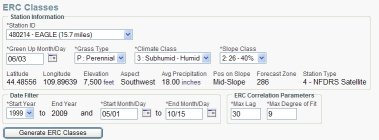How FSPro Uses Historic Weather
The fire behavior specialist (FBS) will select a RAWS available in WFDSS that is representative of weather in the fire area. This selection must take into account numerous factors, such as the station's proximity to the fire, its elevation, position on the slope (valley bottom, mid-slope, ridgetop, etc.), as well as the number of years the station has been reporting.
This is not always an easy balance to find and is one of the reasons that a local subject matter expert(s) (SME) should be advise the FBS about the best RAWS to use. The following image displays RAWS station information (these values should not be changed unless confirmed as incorrect), as well as the date filter values, which the FBS and SME determine. From these inputs, ERC classes are generated.

Eagle RAWS Station Information
ERC information is obtained from the historic RAWS record and is grouped into five classes or bins, as seen in the image below.

Eagle ERC Classes
Each bin is given fuel moisture, burn period, and spotting information. The FBS can adjust the bins, as well as the associated values as needed. FSPro uses this information, along with the historic wind data to generate hundreds of artificial weather scenarios.
In This Section |
See Also |
Reference |